Last updated: November 19, 2022
Article
Bighorn Sheep Reclaimed Abandoned Habitat during the Pandemic and Had Lots of Young. Now What?
I spent weeks informally observing desert bighorn sheep during the 2020 pandemic closure. My observations show where to take our research.
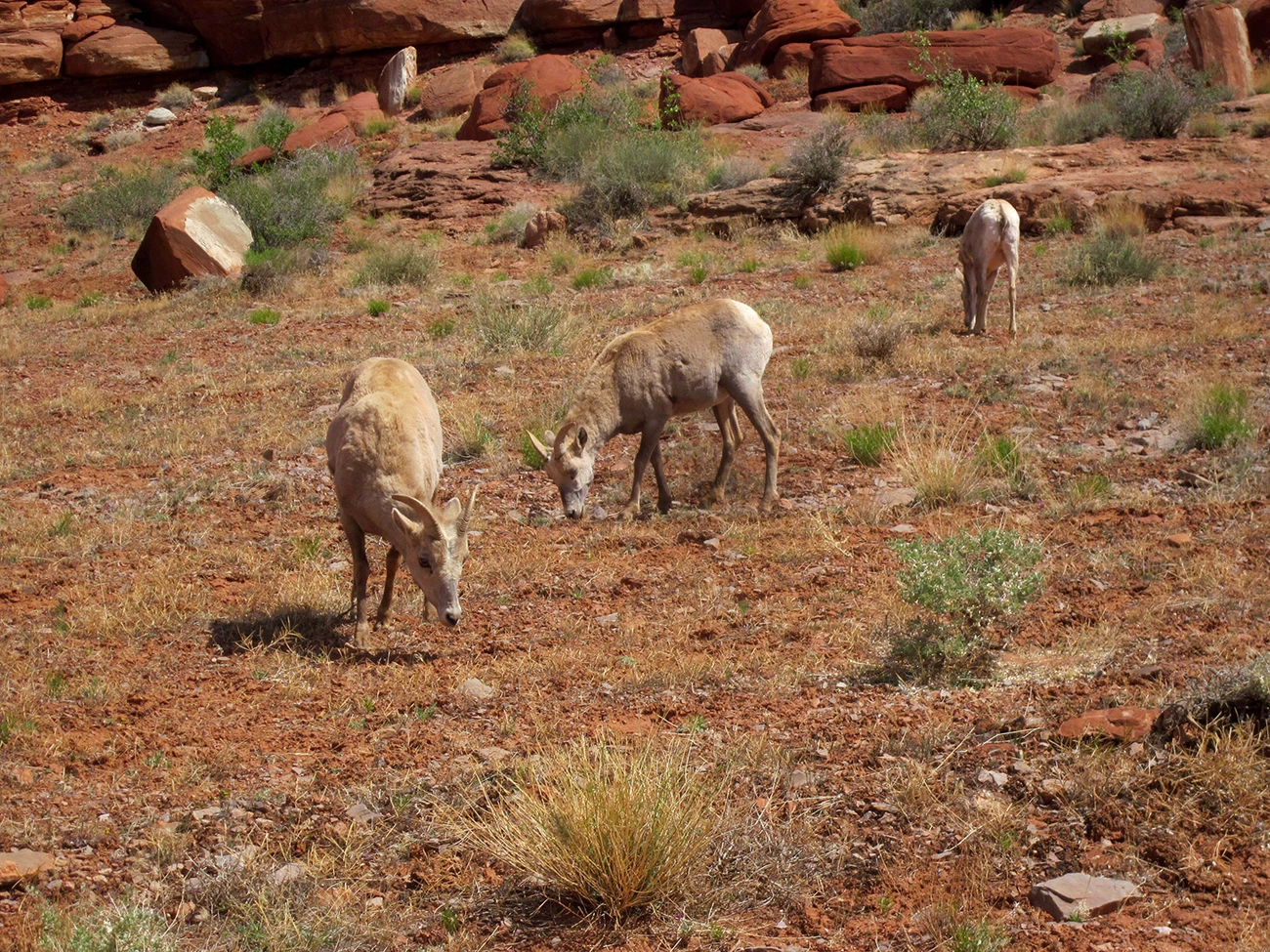
Image credit: NPS / W. B. Sloan
Desert bighorn sheep are some of the most iconic animals you can see in Canyonlands National Park. A fleeting glimpse of these elusive mammals among the rocks can be the highlight of a visit to the park. But loss of habitat along the park’s four-wheel-drive roads, specifically the White Rim Road, poses a significant threat to their future. I spent seven insightful weeks during the pandemic closure examining bighorn sheep use of the White Rim Road in the absence of visitors and traffic. I made some important observations. Sheep were returning to areas they had abandoned for decades. Ewes were producing far more lambs that survived the summer, despite 2020 being a drought year. What do these insights mean for the future of this charismatic animal?
How Bighorn Sheep Respond to Disturbance
Between 1980 and 2016, recreational use in Canyonlands increased by a stupendous 1,362 percent. Long‐term human disturbance on wildlife, and whether that disturbance affects the wildlife population as a whole, often are difficult to determine. Some species respond to disturbance by spending more time scanning for danger and hence less time looking for food. This can be detrimental to their survival. Long-term and intense disturbance can cause shifts in how wildlife use habitat that go unnoticed until the habitat is completely abandoned.
As the day progressed, they reached a threshold of cumulative stress from the disturbances, avoiding the road corridor altogether and moving to habitat with poorer quality food.
In a 1993–1994 study that my colleagues and I did, bighorn sheep in Canyonlands spent more time alert to disturbances from streams of traffic and less time foraging. They appeared to respond to the repeated daily increase in traffic by fleeing. As the day progressed, they reached a threshold of cumulative stress from the disturbances, avoiding the road corridor altogether and moving to habitat with poorer quality food. Our 2001 paper based on this study recommended placing limits on White Rim Road use to protect the sheep population. This resulted in the park’s current permitting system, which limits the daily number of road users year-round.
A Unique Learning Opportunity
In 2020, public health concerns from the pandemic led to regional lockdowns. After the spring pandemic closure, midsummer visits climbed sharply. By fall, visitor totals were at record numbers, up 30 percent in October, 67 percent in November, and 76 percent in December compared to 2019. The National Park Service units of the Southeast Utah Group (Arches, Canyonlands, Hovenweep National Monument, and National Bridges National Monument) closed to the public for nine weeks from March 27 to May 28. I used the closure of the White Rim Road in Canyonlands as an informal opportunity to build upon past research.
The animals I saw during the closure consistently appeared to be in closer proximity to the White Rim Road. Of the 65 sheep observed during the closure, 42 were within 1.1 miles of the road. Of these, 34 were within a half mile from the road. Seventeen of these used habitat within a quarter mile of the road. I observed nine individuals along the roads, some feeding exclusively on greening vegetation. I photo-documented tracks and scat of several groups and numerous individuals in locations along the roads. Apparently, the sheep fed along the road at length while they were undisturbed.
I studiously observed for several days as a maternal group of six sheep returned for the first time to an area abandoned 26 years prior after four campsites were developed. They were feeding and bedding among the campsites and along the road. I also observed a group of ewes feeding on the newly emergent green grass and vegetation immediately alongside the road. In both instances, the sheep were unperturbed by my unintrusive presence in the absence of the stress from steady vehicle traffic, even though they moved to within 65 feet at times.
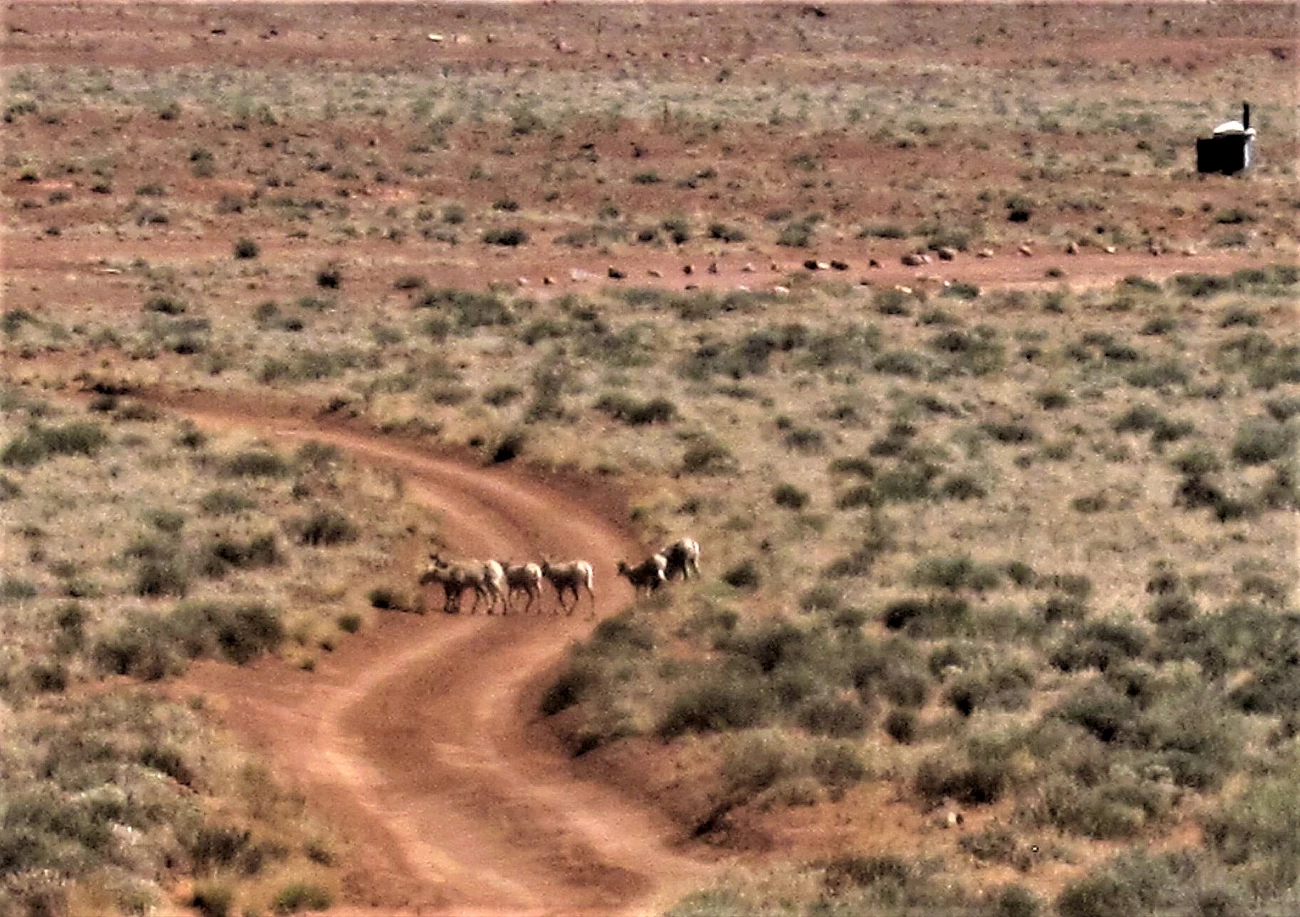
Image credit: NPS / W. B. Sloan
The Importance of the Road
These observations were significant because of their population-level implications. The ewes during their third trimester of pregnancy need the vital nutrients obtained from the tender, green, emergent vegetation to carry a healthy lamb to birth. But our past studies showed that recreational disturbances cause sheep to avoid the road corridor—which has the highest quality forage seasonally—potentially reducing the number of newborns that survive.
I found that a collared ram had moved from the White Rim to the Island in the Sky mesa top. It was an area that sheep had used in the mid-1990s but was abandoned due to increased traffic on the main paved road that bisects the habitat. This was an unexpected and surprising discovery. After two decades and several generations of sheep avoiding the area, they were immediately comfortable again in the absence of traffic. The ram remained near the road in a group of eight animals until the park reopened. Afterwards, it immediately moved over a mile away from the road.
Three months after the gradual reopening of the region to the public, park visits increased to well above average. September through December 2020 were all record-setting visitation months. I documented a significantly greater disturbance response from the sheep during this time, measured by time spent alert and distance fled. I repeatedly observed them increase their vigilance and flight behavior in the face of increased disturbances.
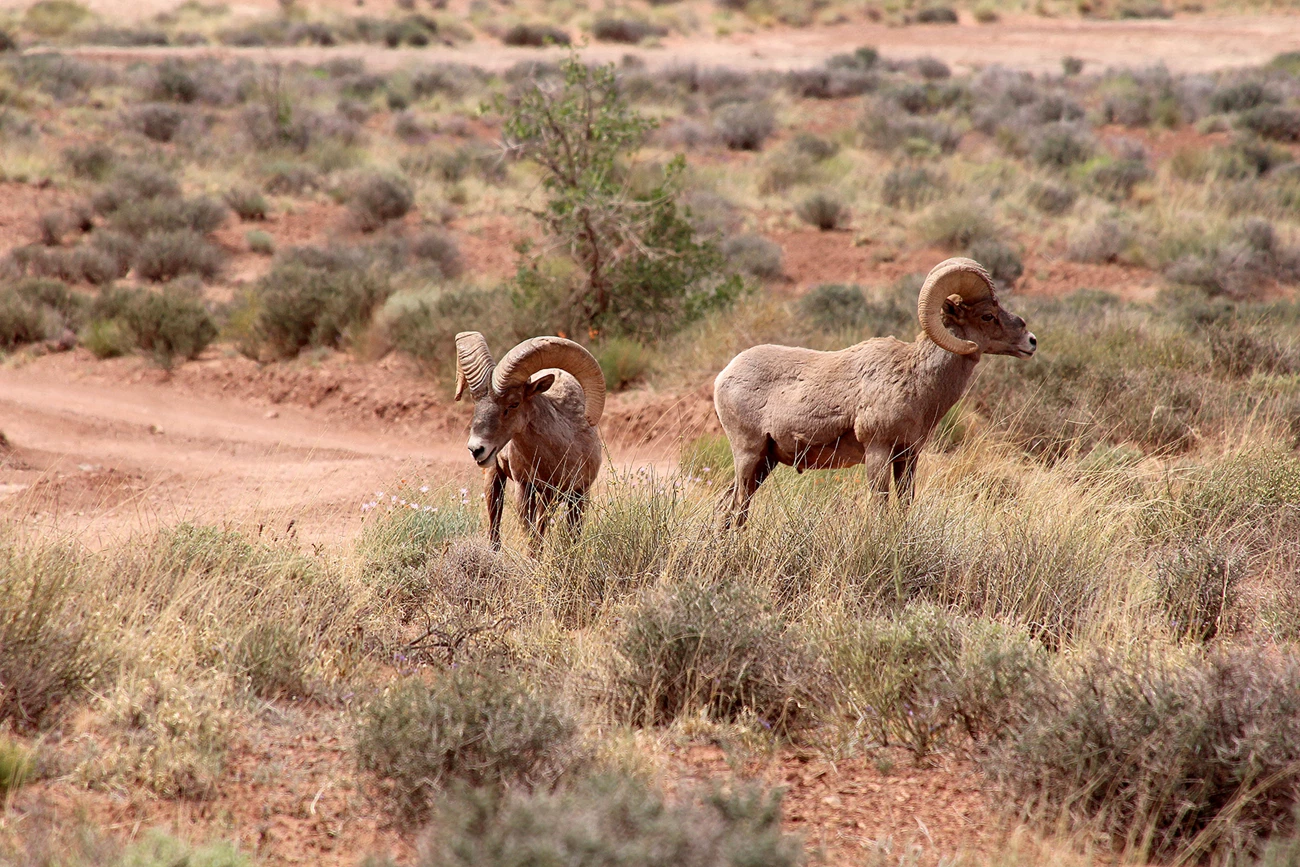
Image credit: NPS / W. B. Sloan
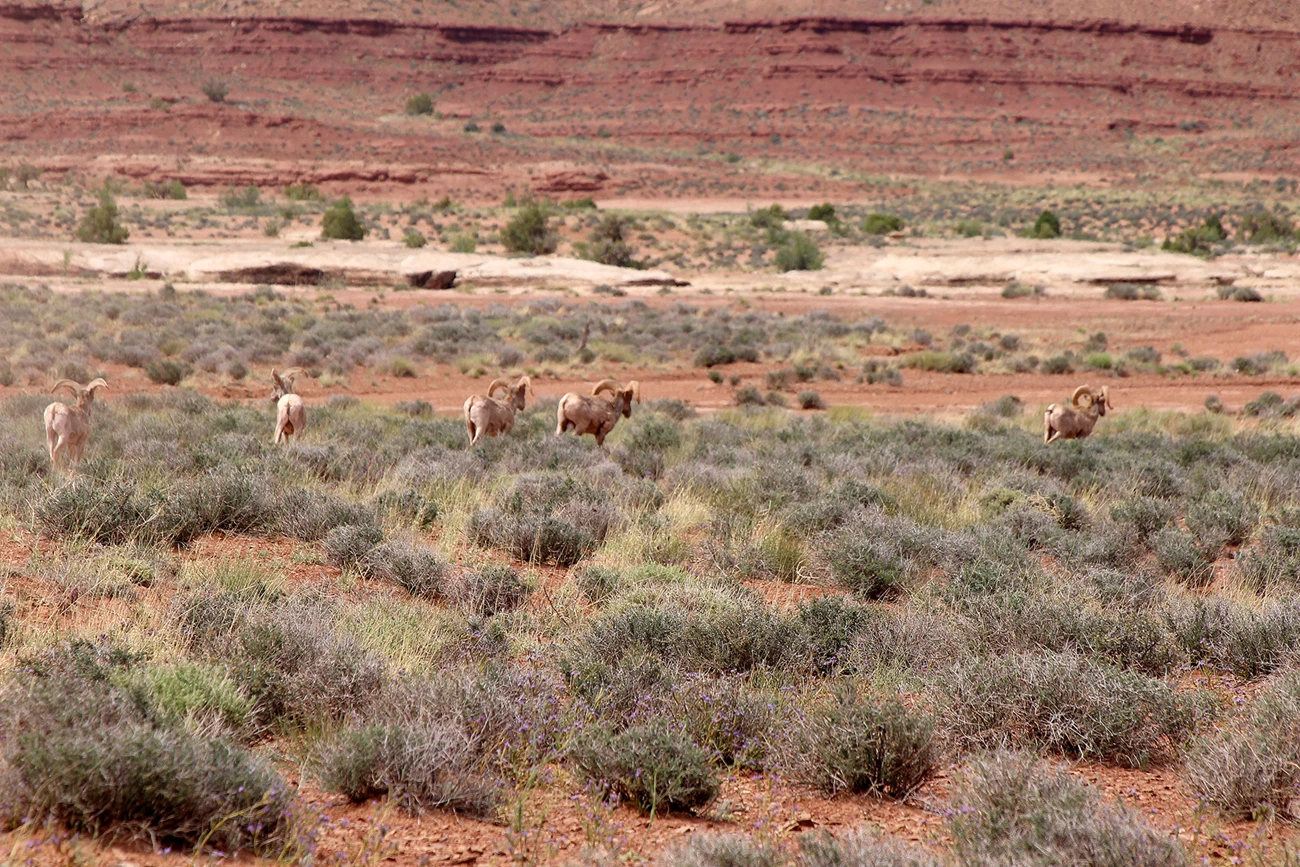
Image credit: NPS / W. B. Sloan
Surprising Increase in Lamb Survival
Lamb survival was excellent throughout 2020 despite extreme drought. Nearly every ewe I tracked with a GPS collar had a surviving lamb. Overall lamb-to-ewe ratio by the end of October was 80 lambs per 100 ewes. The average over the last three decades is closer to 35 lambs per 100 ewes. This means it is possible, if not likely, that the absence of disturbance during the vital spring lambing season allowed pregnant ewes to find more nutritious food. Future study would enable us to check this more rigorously.
Preliminary GPS data on all the collars before, during, and after the closure appear to show the collared animals remaining much closer to the roads during the closure. An analysis of data from several collared animals indicates them moving around less and staying in closer proximity to the roads once the closures began.
Overall lamb-to-ewe ratio by the end of October was 80 lambs per 100 ewes. The average over the last three decades is closer to 35 lambs per 100 ewes.
Overall, the sheep responded favorably to the elimination of recreational use along the White Rim Road. Significantly, both ewes and rams returned to critical habitat that had been abandoned over two decades ago. My observations frequently found the animals feasting on the fresh new green plants along the road. As a result, healthier, stronger lambs were born. Ewes were stronger to nurse their young through the hot and dry summer months, and more lambs survived.
Some Questions Remain
In my prior studies, I documented disturbance as altering the foraging efficiency of ungulates. Such impacts can cause a decline of nutrient intake and may ultimately have negative effects on populations. Small changes in diet quality can result in significant nutritional changes over time, affecting a population’s ability to thrive. An increase in energy expenditure and a decrease in nutrient intake can cause declines in survival and distribution, shifts in habitat, and ultimately, a decrease in population size.
I plan to do further research to determine the extent to which recreational traffic is preventing sheep from consuming the vegetation along the road corridor. The specific goals in these new studies are to develop a fundamental understanding of how recreation is affecting bighorn sheep. To what extent is it causing abandonment of suitable habitat? Are there associated bio-energetic costs from disturbance-induced flight to late-stage pregnancy and lamb survival? Given the incredible increase in visitation, these studies will allow us to understand recreation’s impact on bighorn sheep movements and behaviors. They will help us find ways to mitigate and reduce negative interactions.
Actions We Can Take
Based on my observations and research, in order to better protect the fragile sheep population on the White Rim Road in the face of sharply increasing visitation and recreational pressures, I recommend we take certain actions. These include seasonal camp closures, reduced vehicle and bike traffic, reduction of the current permitting level, and restrictions upon climbing and off-trail hiking. These actions would remove stress and reduce flight response during the lambing period, a time of heightened sensitivity. Seasonal closures or restrictions should be from March 1 through August 31 annually. Bighorn sheep had a markedly positive response to the lack of disturbances during the pandemic closures. It is exciting to see this charismatic animal return to its native habitat. If we value native sheep on the White Rim Road, we need to act to preserve this experience.
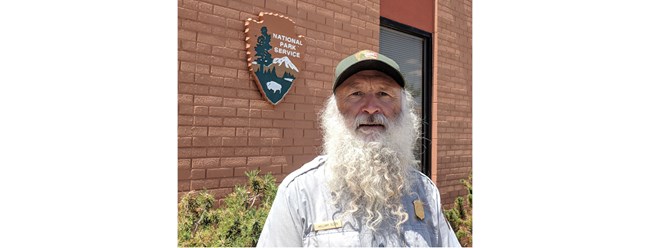
About the author
Bill Sloan is a wildlife biologist at Canyonlands National Park, Arches National Park, and Death Valley National Park. He has studied bighorn sheep at 27 NPS units for the past four decades. He has published several studies about the recreational impacts of visitation on bighorn sheep populations.
Image credit: NPS / J. Chis Wonderly
